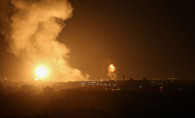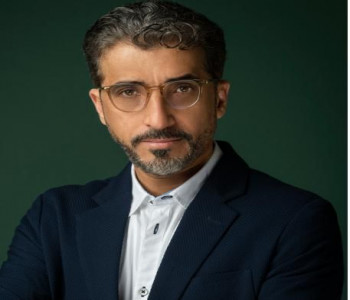Revolutionary Guard member shot dead in Tehran: Who is behind the increasing assassinations?
Revolutionary Guard member shot dead in Tehran: Who is behind the increasing assassinations?
In a continuation of the internal unrest in Iran, a member of the Iranian Revolutionary Guard Corps (IRGC) was killed by gunfire near his house in southern Tehran on Tuesday evening, according to the official media.
The Tasnim news agency announced that the dead officer, named Qassam Fathollahi, was the commander of the Thar Allah headquarters of the Imam Sajjad Mosque in Greater Tehran.
IRNA news agency reported that Fathollahi “was martyred after being targeted by unknown persons in a shooting incident.”
It indicated that Fathollahi was “wounded by four bullets in front of his house” on Mokhtari Street, south of the Iranian capital.
IRNA explained that the police opened an investigation into the incident and detected “signs of theft from apartments in the vicinity, adding that he may have been killed during a burglary.”
Since September 16, Iran has witnessed protest movements following the death of the young woman Mahsa Amini after she was arrested by the morality police in Tehran for not adhering to the strict dress code in the country.
Hundreds were killed, including dozens of members of the security forces, during the protests, which included raising slogans against the authorities. Thousands have also been arrested on the sidelines of the movement, which Iranian officials consider a “large part of as riots behind which foreign enemies stand.”
The judiciary issued death sentences against 13 people in connection with the protests, two of which were executed in December after being convicted of assaulting members of the security forces. The Supreme Court confirmed four other death sentences that were issued, according to what was reported by AFP.
Mossad penetration of the Iranian regime
“In recent years, the Israeli Mossad's penetration into Iran has become an irrefutable fact, the impact of which appeared in the multiplicity of assassinations of scientists and leaders. The most recent of them was Mohsen Fakhrizadeh, the Iranian nuclear scientist who was assassinated in a professional intelligence operation that was carried out remotely,” according to Sayed Hussain, a researcher specializing in Iranian affairs.
He explained to Jusoor Post that “this operation was a milestone in the record of penetrating the Iranian interior, as it came very accurately without any civilian casualties.”
“This confirms that the perpetrator of the operation obtained accurate and documented information about the target and its movements, to show the weakness of Iranian intelligence capabilities in the face of these infiltration operations,” he said.
Hussain added that “in addition to the major operation carried out by the Israeli intelligence elements in one of the nuclear facilities, Israel obtained documents about the reactors, which made it easier for the Israeli side to target the nuclear facilities, whether by bombing them or by carrying out hacking operations and disrupting the work of centrifuges more than once.”
Meanwhile, Mohammad Mansour, a researcher at the Egyptian Center for Thought and Strategic Studies, believes that it is possible to say that targeting prominent IRGC leaders recently is a harvest of the internal role of the Basij forces affiliated with the Guard in the Iranian internal equation and the external roles of the Quds Force and the groups associated with it in the regional scope, starting from the Red Sea in the south, through Syria, to the Gaza Strip. These roles resulted in an open and unconventional sea, air, and land confrontation between Tehran and Tel Aviv.
Despite the difficulty of recognizing the Israeli espionage operations in a repressive, hard-line state, according to researcher Sayed Hussein, the present reasons facilitate the work of the intelligence services at the internal level.
He explained, “After what was called the Islamic Revolution, the new regime did not try to contain different ethnicities and nationalities, declaring the establishment of an ideological state, which resulted in political disputes that ended in the regime's abuse of all its opponents, even its allies in the revolution against the Shah.”
In this context, the Washington Post conducted an investigation in early December 2022 revealing government documents and interviews with 15 officials in Washington, Europe and the Middle East.
These documents confirmed that “the government of Iran has intensified its efforts to kidnap and kill dissidents, activists, and journalists, whom it considers a threat to the regime in many countries, including the United States of America.”
The officials told the newspaper, on condition of anonymity, that “Iran's intelligence and security services relied to a large extent on proxies to carry out their plans. It offered hundreds of thousands of dollars to jewelry thieves, drug dealers and other criminals in assassination schemes for cash.”
Iran International revealed the leaked secret bulletins of Iran's Fars News Agency, which is affiliated with the Revolutionary Guard. According to the latest documents circulated on Friday, December 2, addressed to IRGC Commander-in-Chief Hossein Salami, the Iranian authorities were aware of the recent attack on Shahcheragh Shrine in Shiraz, “but did not prevent it.”
On the internal level, muffled tensions have arisen in recent years between the regular forces in the Iranian army and the Revolutionary Guard, as researcher Mohammad Mansour explained the accelerating pace of assassinations.
“The hidden tensions between the army and the Guard are related to the state of deliberate marginalization of the regular force, so that it does not have the slightest participation in drawing up foreign or internal policies, not to mention the weakness of the roles granted to it at the internal level,” he said.
“However, on the other hand, the Revolutionary Guard penetrated deeply into the political and economic joints of the Iranian interior, in addition to its multiple external roles, which include a wide range of countries allied to Tehran,” Mansour added.







